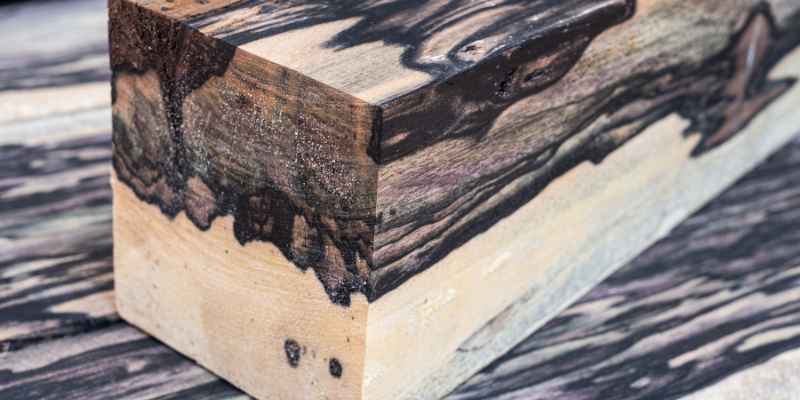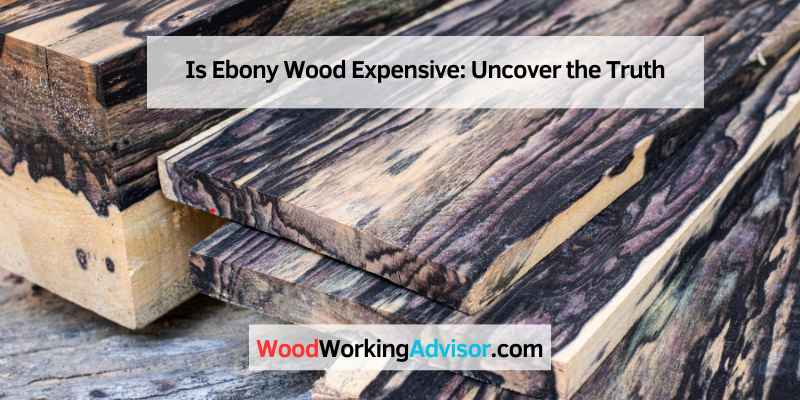Ebony wood is considered one of the most expensive woods in the world, with a price tag that can make your head spin. It is highly sought after for its finely textured, mirror-like finish when polished, making it valuable as an ornamental wood.
Ebony wood is commonly used in the production of high-end furniture, musical instruments such as clarinets and oboes, as well as decorative items. With its scarcity and unique qualities, ebony wood commands a premium price in the market.
The Significance Of Ebony Wood
Historical And Cultural Importance
Ebony wood holds great historical and cultural significance, especially in African and Asian cultures. It has been esteemed for centuries and has played a vital role in traditional woodworking practices, art, and craftsmanship.
Applications In Various Industries
Ebony wood finds diverse applications in various industries, including music, furniture making, ornamental work, and high-end decorative items. Its rich, dark color and dense composition make it highly sought after for creating luxurious and visually striking products.
Factors Affecting The Price
Ebony wood’s hefty price is influenced by its rarity, fine texture, and high demand for luxury items. Its mirror finish and ornamental value make it one of the priciest woods globally.
Scarcity And Sustainability
Ebony wood, known for its stunning black color and luxurious appearance, is renowned for its high price tag. One of the main factors contributing to the expensive nature of ebony wood is its scarcity and sustainability.
Due to overexploitation and illegal logging, ebony trees have become increasingly scarce in many regions, particularly in Africa where the wood is predominantly sourced. The limited availability of ebony wood drives up its price as the demand outweighs the supply. With the growing concern for sustainable harvesting practices, the scarcity of ebony wood makes it an even more coveted and valuable resource.
Quality And Characteristics
Another significant factor influencing the price of ebony wood is its quality and characteristics. Ebony is highly valued for its exceptional durability, density, and fine-textured grain. The wood is hard, resistant to rot and insects, making it ideal for high-end furniture, musical instruments, and artisanal crafts.
Furthermore, ebony wood has unique aesthetic features that contribute to its desirability. Its deep black color, often with striking variations and patterns, creates a visually stunning appearance that adds a touch of elegance to any project. The natural luster and polish of ebony wood further enhance its value, turning it into a prized material for luxury items.
When purchasing ebony wood, the quality and characteristics play a crucial role in determining its price. High-quality ebony, with uniform color and grain patterns, is more expensive due to its rarity and the craftsmanship required to work with such a refined material.
Comparative Analysis
Ebony wood is renowned for its luxurious appeal, making it one of the most expensive wood types globally. Its rarity and unique properties contribute to its high cost in premium furniture and instrument crafting industries.
Comparison With Other Expensive Woods
When it comes to the world of fine woodworking, ebony wood is often revered as one of the most luxurious and sought-after materials. Its dark, rich color and beautiful grain pattern make it highly desirable for high-end furniture, musical instruments, and decorative items. But just how expensive is ebony wood compared to other types of wood? Let’s take a closer look.
To put things into perspective, ebony wood is often cited as one of the most expensive woods in the world. However, it is important to note that there are other woods that can give ebony a run for its money in terms of price. One such wood is African Blackwood (Dalbergia melanoxylon), which is commonly used in the production of musical instruments like clarinets and oboes.
African Blackwood is renowned for its exceptional durability, density, and tonal qualities, making it a popular choice among professional musicians. Its scarcity and limited availability contribute to its high price tag, making it a serious competitor to ebony wood in terms of cost.
Another wood that deserves mention in the category of expensive woods is sandalwood. This fragrant and highly valued wood is known for its distinct aroma and is often used in the production of luxury items such as perfumes, incense, and carvings. Sandalwood’s scarcity and unique properties make it a prized material, often fetching high prices in the market.
Regional Variations In Pricing
It is worth noting that the price of ebony wood can vary depending on its origin and availability. For example, Gaboon ebony, which is sourced from Gabon in West Africa, is considered one of the finest and most desirable varieties of ebony wood. Its consistent dark color and fine texture make it highly sought after for high-end furniture and musical instruments.
On the other hand, Macassar ebony, derived from Southeast Asia, is known for its distinctive striped appearance, which adds a unique aesthetic to any piece of furniture or decorative item. The rarity of Macassar ebony contributes to its higher price compared to other varieties of ebony wood.
It’s important to keep in mind that regional variations in pricing also extend to other types of wood. Factors such as transportation costs, availability of raw materials, and local demand can greatly impact the price of wood in different regions.
In conclusion, while ebony wood is often touted as one of the most expensive woods in the world, it faces competition from other luxurious and rare woods such as African Blackwood and sandalwood. Regional variations in pricing also play a significant role, with certain varieties of ebony wood commanding higher prices due to their superior quality or unique characteristics.
Economic Value Of Ebony Wood
Ebony wood is renowned for its economic value and is considered one of the most expensive woods in the world. Its fine texture and mirror-like finish make it highly sought after for ornamental purposes, as well as for making musical instruments and high-end furniture.
Market Demand
Ebony wood is in high demand across various industries such as musical instrument making, high-end furniture, and ornamental woodwork. The scarcity and unique properties of ebony wood make it highly sought after, leading to a consistent market demand and premium pricing.
Impact On Local Economies
The economic impact of ebony wood on local communities is substantial. In regions where ebony trees are found, the harvesting and trade of ebony wood significantly contribute to the livelihoods of local populations. However, unsustainable logging practices and illegal trade can lead to environmental degradation and threaten the long-term economic sustainability of these regions.
Environmental Concerns
When it comes to ebony wood, it is crucial to consider the environmental impact of its production and harvesting.
Deforestation And Conservation Efforts
Deforestation:
- Ebony trees are facing severe deforestation due to high demand and illegal logging practices.
- This threatens the natural habitat of various species and alters the ecosystem balance.
- Ebony wood is extracted faster than it can replenish, leading to ecological imbalance.
Conservation Efforts:
- Some organizations are working on sustainable harvesting practices to protect ebony forests.
- Raising awareness about the importance of preserving ebony trees is crucial for long-term sustainability.
- Efforts are being made to replant ebony trees and restore damaged ecosystems.
Regulations And Ethics
Regulations:
- There are strict regulations in place to control the harvesting and trade of ebony wood.
- Permits are required for the export and import of ebony to ensure legal sourcing.
- Regulatory bodies monitor the supply chain to prevent illegal logging activities.
Ethics:
- It is essential to promote ethical practices in the ebony wood industry to protect the environment and local communities.
- Respecting indigenous rights and traditional knowledge is vital for sustainable ebony wood production.
- Supporting fair trade initiatives helps in ensuring a just distribution of profits from ebony wood trade.
Future Prospects
Ebony wood is considered one of the most expensive woods globally, sought after for its luxurious appeal and rarity. Its use in high-end furniture, musical instruments, and decorative items contributes to its hefty price tag, making it a valuable investment for future prospects.
When it comes to the future prospects of ebony wood, several factors need to be considered. These include the availability of the wood, alternative materials and substitutes, as well as technological innovations in woodworking. Let’s explore these aspects in more detail.
Alternative Materials And Substitutes
As the demand for ebony wood continues to rise, the scarcity of this precious resource poses a challenge. However, there are alternative materials and substitutes that can be considered. Some of these include:
- African Blackwood: Similar in appearance and properties to ebony, African Blackwood is often used as a substitute due to its rich color and durability.
- Dark-stained Woods: Certain hardwoods, such as mahogany or walnut, can be stained to resemble ebony, providing a cost-effective alternative.
- Engineered Wood: Engineered wood products, such as laminates or veneers, offer a more affordable option while still mimicking the aesthetic qualities of ebony.
Technological Innovations In Woodworking
In addition to alternative materials and substitutes, technological innovations in woodworking present an exciting prospect for the future of ebony wood. These advancements allow for more efficient utilization of the available resources and offer sustainable solutions. Some of the notable innovations include:
- 3D Printing: The use of 3D printing technology enables the creation of intricate ebony wood replicas, reducing the demand for natural ebony while still maintaining its visual appeal.
- Nanotechnology: Nanotechnology can enhance the durability and strength of wood by modifying its properties at the molecular level, providing alternatives to traditional hardwoods like ebony.
- Wood Recycling: Recycling techniques, such as repurposing ebony from old furniture or reclaimed sources, contribute to the conservation of this valuable wood species.
These technological breakthroughs not only offer sustainable alternatives to ebony wood but also open up new possibilities in woodworking and design.
In conclusion, while ebony wood remains one of the most expensive woods in the world, future prospects are hopeful. With the exploration of alternative materials and substitutes, as well as technological innovations in woodworking, the scarcity of ebony wood can be mitigated, ensuring its continued use in a sustainable and environmentally conscious manner.

Frequently Asked Questions On Is Ebony Wood Expensive
What Is The Cost Of Ebony Wood?
The cost of ebony wood can vary, but it is considered one of the most expensive woods globally. Prices can be high due to its rarity and valuable ornamental properties. The cost of ebony wood can make it a significant investment for woodworking projects.
Is Ebony The Most Expensive Wood?
Ebony wood is considered one of the most expensive woods in the world. It is highly sought after for its fine texture, mirror-like finish, and ornamental value. African Blackwood is another expensive wood used for musical instruments and high-end furniture.
Both woods are valuable due to their rarity and unique characteristics.
Why Is Ebony So Valuable?
Ebony wood is valuable for its fine texture, mirror finish when polished, and ornamental qualities.
What Type Of Wood Is The Most Expensive?
The most expensive wood is typically African Blackwood, valued for musical instruments and high-end furniture.
Conclusion
Ebony wood is considered one of the most expensive woods in the world due to its rarity and unique characteristics. It is highly sought after for its use in making musical instruments, high-end furniture, and decorative items. The price tag associated with ebony wood can be quite high, making it a valuable and desirable choice for those in search of luxury and elegance.
With its finely textured and mirror-like finish, ebony wood continues to be a symbol of sophistication and craftsmanship in the woodworking industry.


